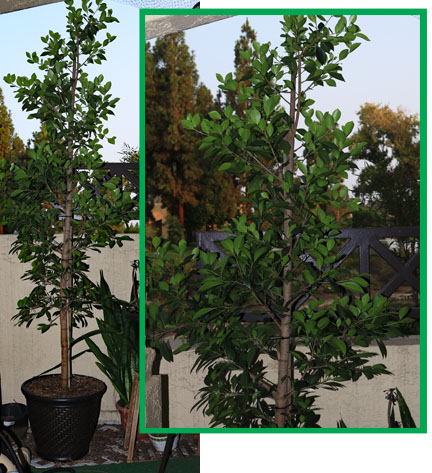Have you seen this new insect pest?
A recently introduced insect, the Ficus leaf rolling psyllid (FLRP) is attacking Ficus plants in San Diego County and Southern California. It is a tiny flying pest that damages Ficus macrocarpa (F. nitida).
Our potted Ficus on our patio in Chula Vista, California had a severe infestation first seen in late July.
After consulting some university websites we learned the symptoms and gained insight for treatment.
Pruning the affected leaves and disposing to remove the pests they harbor is recommended. In our case we had to reduce the overall size of the plant by almost half. The branch ends on the entire tree were affected. FLRP seemingly prefers newly emerged tender leaves.
Information about treating FLRP is sketchy. The pest is still very new to the U.S. Doing some digging on the internet we learned that two different pesticides may help: imidacloprid and Neem oil. We used both.
Imidacloprid is a systemic insecticide. It is taken up by the plant’s roots and translocated throughout. It is effective against sucking pests like FLRP. Need oil is natural contact pesticide.
With any pesticide read and follow label directions.
We purchased a granular imidacloprid+clothianidin product. It is applied by sprinkling on the soil and watering in. We treated three times at 10 day intervals beginning in early August. At first the control was slow. But over the next few weeks we saw fewer and fewer rolled leaves.
The entire plant was sprayed with Neem oil in late August, and a follow up spot treatment on September 3.
No curled leaves have been seen since September 4.
Our control appears to be complete. Our Ficus in healthy again.
I have been in contact with Dr. Surendra K. Dara at the University of California Agriculture and Natural Resources dept. (UCANR) about my experience with FLRP. He posted my email to him in his recent article:
Dr. Dara:
Management
No information is currently available about the management of FLRP. Leaf-rolls are likely to protect the immature stages from contact insecticides and possibly from some common natural enemies. Although wings, lady beetles, and minute pirate bugs were found on the foliage of the infested trees, their role as potential biocontrol agents is not clear. Initial observations indicated that infestations were higher on trees with younger leaves. Since FLRP appears to have a tendency to infest newly emerging leaves, careful scouting and removal (and bagging) of the infested leaves can help reduce the spread of infestations. Depending on the level of infestation and life stages of the pest, contact insecticides for adults and systemic insecticides against immature stages can be considered. Ficus microcarpa cultivars Green Gem and Variegata, which are resistant to some pests, does not seem to resist FLRP.
Input from a client:
"We successfully controlled a severe outbreak of FLRP on our potted Ficus microcarpa in Chula Vista CA. I first noticed the rolled leaves in late July. Within 10 days many of the leaves on the ends of all of the branches showed FLRP. I treated with granular imidacloprid (.55%)+clothianidin per directions and watered in. This control worked slowly at first. For 21 days we still saw FLRP in ever reducing numbers. I retreated every 10 days. We also used Neem oil on the entire plant in late August, and spot treatment on Sept. 3. We now have complete control. No curled leaves have been seen since September 4. This method has of control worked for us."
David Pearling, trained horticulture expert
Here is a link to the article. It has very good photos that may help you identify this pest and the damage:
And here is a photo of our now healthy Ficus macrocarpa and two images image copied from Dr. Dara’s article showing typical damage.





Extremely useful information which you have shared here. This is a great way to enhance knowledge for us, and also beneficial for us. Thank you for sharing an article like this. Succulent Delivery Sydney
ReplyDelete